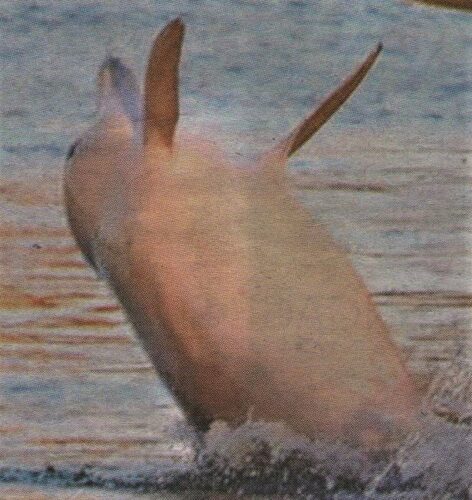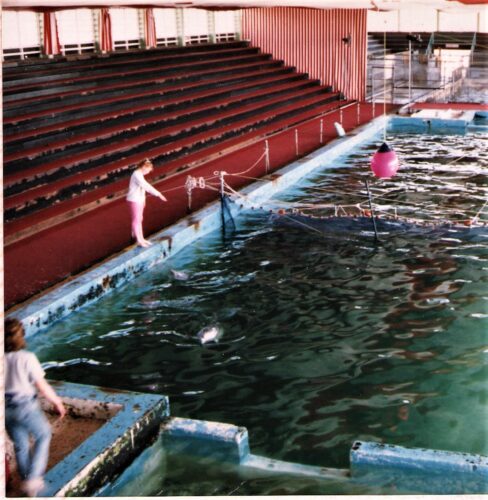More on the Tailwalking Port River Bottlenose Dolphins
by Steve Reynolds
After reading my recent article about Adelaide’s Marineland Dolphins, Dan Monceaux made the following comment: –
“According to Mike Bossley of WDC (Whale and Dolphin Conservation Society), at least one of the Marineland dolphins was released into the wild locally and re-joined the Port River pod, where he/she taught other dolphins how to tailwalk. That behaviour lives on today in subsequent generations of the population… a great demonstration of the way dolphins are able to pass knowledge down from generation to generation.”

A dolphin tailwalking at the bow wash of a tug on the Port River
As featured in a Messenger Community News newspaper on 25th April 2018:
(Cropped from photo taken by Jenni Wyrsta)
My response to Dan was, “That dolphin was Billy/Billie. She had become trapped in the Patawalonga Lake at Glenelg in 1988 (something that occurs regularly now). She was subsequently rescued from the lake.
I, myself, had been involved in an earlier dolphin rescue near Outer Harbor. I was, however, unable to assist in this latest rescue attempt, so I enlisted the help of Frank Wendland, another Marine Life Society member. The dolphin was rescued, with Frank’s help, and was taken to Marineland until she could be released back in to the wild.
(I now have to admit that I have probably confused my dates and dolphin rescues.)

Messenger newspaper photo of a South Australian dolphin rescue
(Courtesy of Channel 9)
“Billy/Billie was the same dolphin that had become a celebrity in 1987 when she was photographed by the late Martin Jacka, a former News Ltd (Advertiser) photographer, swimming alongside racehorse trainer Sandy Sandford’s horse and dog in the Port River. She was named Billy by Sandford, but this was changed to Billie when it was realized that she was a female dolphin. She disappeared from the river in 1988 and turned up in the Patawalonga Lake.
(Martin Jacka died in 2018. As for Billy becoming Billie, it is not the first time that there has been confusion about the gender of a SA dolphin. There was the case of Jock becoming Jockette.)
“Whilst Billie was being kept at Marineland after being rescued from the Patawalonga Lake, she copied the regular captive dolphins there and started tailwalking. This involved standing upright in the water and running backwards.
Marineland closed in 1988. Billie was returned to the Port River about this time, and she continued to tailwalk there. Her antics were soon picked up by other Port River dolphins, including Wave and, later on, her daughter Ripple. Wave was known to do as many as 50-60 tailwalks a day. Billie was in her mid-20s when she prematurely died of kidney failure in 2009. “
Billie gave birth to a calf in April 1995, but the calf died from the poisonous effects of her mother’s toxic milk.
Wave had given birth to a stillborn calf in 2013. Wave disappeared altogether in 2014. One of her calves (Bronny) died in 2015. Ripple lost her calf Marea due to toxic chemicals in her body. Her second calf (Holly) was born in December 2017 but was soon killed when struck by a boat.
This photo taken by Jenni Wyrsta of a dolphin tailwalking at the bow wash of a tug on the Port River featured in a Messenger Community News newspaper on 25th April 2018: –

Up until 2018, only the Port River dolphins (those dolphins within the Adelaide Dolphin Sanctuary) had been seen tailwalking. Late in 2018, however, Jenni Wyrsta took this photo of three-year old female dolphin June tailwalking at Glenelg: –

June apparently travelled between the Port River and Glenelg with her mother Lartelare.
Jenny witnessed June doing two tailwalks by the Glenelg marina. Jenni said that it was the first time that June was known to have tailwalked at all.

June tailwalking at the Glenelg marina
(Cropped from Jenni Wyrsta’s photo above)
According to the web page found at https://dolphinsocietyau.wordpress.com/bottlenose-dolphins/, “Near Adelaide, in South Australia, three bottlenose dolphins ‘tail-walk’, whereby they elevate the upper part of their bodies vertically out of the water, and propel themselves along the surface with powerful tail movements. Tail-walking mostly arises via human training in dolphinaria. In the 1980s, a female from the local population was kept at a local dolphinarium for three weeks, and the scientist suggests she copied the tail-walking behaviour from other dolphins. Two other wild adult female dolphins have now copied it from her.”
The whole matter featured on a BBC News web page, including the comments, “In the 1980s, Billie, one of the females in the group, spent a few weeks in a local dolphinarium recovering from malnutrition and sickness, a consequence of having been trapped in a marina lock. She received no training there, but may have seen others tail-walking. Now, other females in the group have picked up the habit. It is seen rarely in the wild, and the obvious inference is that they have learned it from Billie. “This indicates that they do learn from each other, which is not a surprise really, but it does also seem that they exhibit elements of what in humans we would call ‘cultural’ behaviour,” said Dr Bossley. “These are things that groups develop and are passed between individuals and that come to define those groups, such as language or dancing; and it would seem that among the Port River dolphins we may have an incipient tail-walking culture.””
All of the above suggests that only females have been seen tailwalking.
By the way, our 1987 Marineland dive with the dolphins was supposed to be restricted to 4 divers in the pool at a time, and just for 30-45 minutes. There were also supposed to be some turtles in the pool, but I don’t recall them at all. It cost $15 per diver. No one was allowed to harass or feed the dolphins, or dive with a cold. We each had to sign an indemnity form and comply with all directions from staff.

In 1982, female dolphin Buttons gave birth to a calf, only the second such event in SA. It was the second dolphin birth at Marineland in just 13 months. That appears to be how Marineland’s four dolphins became six. It seems that our dolphin dive was done with the first-born calf called Tuffy, and a second dolphin (age unknown) called Salty.
(The header image of a dolphin tailwalking at the bow wash of a tug on the Port River has been cropped from a photo taken by Jenni Wyrsta, as featured in a Messenger Community News newspaper on 25th April 2018)

